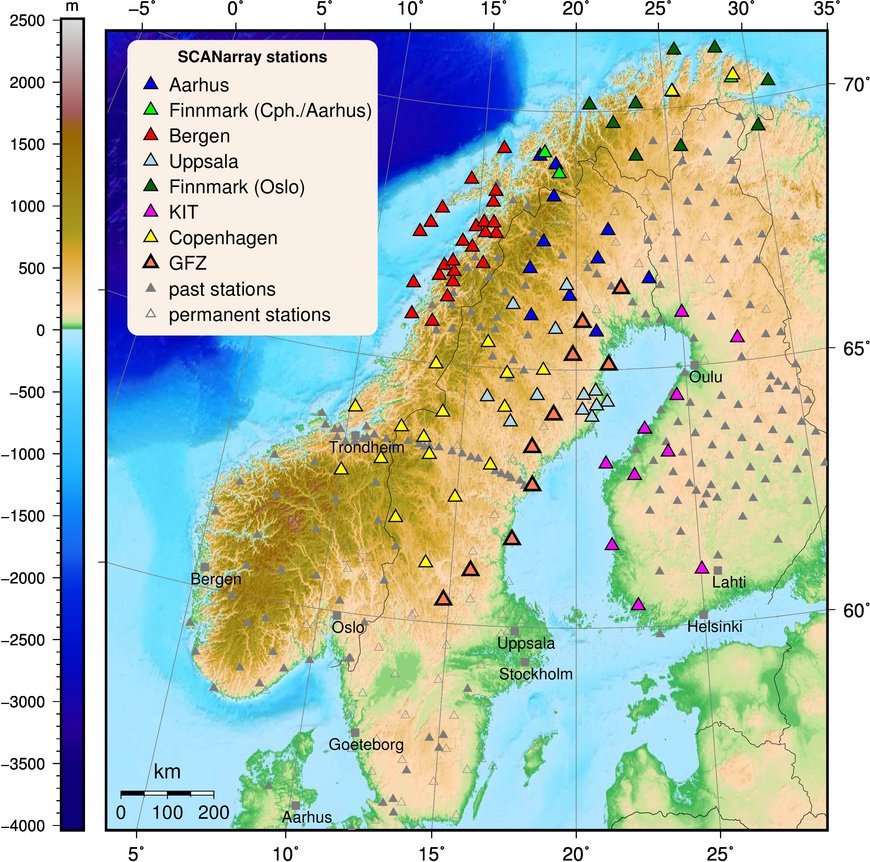LITHOS-CAPP: LITHOspheric Structure of Caledonian, Archaean and Proterozoic Provinces
Contribution to Scan Array
The western rim of Scandinavia is characterized by the Scandes mountain range with topographies up to 2500 m. Since this region lacks of recent compressional tectonic forces, it provides a great opportunity to understand the geodynamical evolution of crustal and upper mantle structures at passive continental margins. This project is the German contribution (GFZ and Karlsruhe Institute of Technology) to the SCANarray initiative implemented by a consortium including also NORSAR, NGU (both Norway) as well as Universities of Copenhagen, Oslo, Leicester, Uppsala, Bergen, Aarhus and Oulu. In the fall of 2014, in total 98 broadband stations have been deployed by the project partners covering central and northern Norway and Sweden and the western margin of Finland; 20 broadband seismic stations were provided by GFZ and will be operated for 2 years. Our project links to former studies which mainly covered the southern regions of Scandinavia. An unusually shallow crust and lithosphere-asthenosphere boundary have been found beneath the high-topography Scandes mountain range of western Norway, where a clear crustal mountain root seems to be absent. The lower topography regions of eastern Norway and Sweden, however, reveal a thicker crust which is in contrast to the principles of Airy isostasy. Lower seismic velocities than expected for a tectonically stable region have been found for southern Norway with a sharp transition to higher VP and VS beneath Sweden. To obtain a high-resolution (lithospheric) shear wave model, we will combine tomographic and waveform inversions of surface waves and ambient noise subsequently producing 3D velocity models, including both isotropic and anisotropic analyses. The focus is on the variation of crustal and lithospheric structure as well as seismic velocity across the Scandes mountain range and western (Phanerozoic) and eastern (Proterozoic) Scandinavia. The spatial variation of anisotropic structures can give us a hint at the tectonic formation since anisotropy may differ between the tectonic units or could be consistent over larger regions.
Time frame
- 2014 - 2019
Principal Investigator
- F. Tilmann (GFZ Potsdam)
Personnel
- A. Mauerberger (PhD) (GFZ Potsdam)
Funding
- DFG Deutsche Forschungsgemeinschaft
Partner
- J. Ritter (Karlsruhe Institute of Technology)
- ScanArray consortium: Universities of Copenhagen, Oslo, Uppsala, Bergen, Aarhus, NORSAR, University Oulu, NGU
Website
Research Unit(s)
- RU2 (Plate Boundary Systems)
Publications
- Grund, M., Mauerberger, A., Ritter, J. R., Tilmann, F. (2017): Broadband Recordings for LITHOS-CAPP: LITHOspheric Structure of Caledonian, Archaean and Proterozoic Provinces, Sep. 2014 - Oct. 2016, Sweden and Finland, (Scientific Technical Report STR - Data ; 17/02) (GIPP Experiment and Data Archive), Potsdam : GFZ German Research Centre for Geosciences. doi.org/10.5880/GIPP.201417.1 |
- Thybo, H., Balling, N., Maupin, V., Ritter, J., Tilmann, F.. (2012): ScanArray Core (1G 2012-2017).DOI: doi.org/10.14470/6T569239(Data publication)



